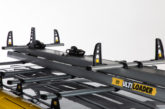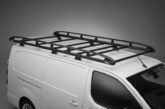
Charles Stubbings, Account Manager at Moneybarn, runs through some key maintenance checks.
Tidy tyres
LCV tyres, like car tyres, must have a minimum 1.6mm of tread. Bald tyres not only increase the likelihood of an accident due to less grip but could also keep you off the road while you find a spare.
Tyres must be inflated to the vehicle manufacturer’s specification for the weight of the load, so refer to your handbook to find the right pressure for your van.
Under-inflated tyres generate more heat from friction, causing more wear and tear to the tyres and impacting fuel consumption. Similarly, over-inflated tyres cause premature wear on the centre of the tyre.
Under the bonnet
Before you open the bonnet, check underneath your van for any leaks. Under the bonnet, check the oil, water/coolant, power steering fluid, brake fluid and windscreen washer fluid. Perform these checks weekly and before any long journey.
After the fluids, take a look at the battery. Check the condition of the terminals and cables for any signs of cracking, breaking or built-up residue. If you notice any of these, book your van in with a mechanic as soon as possible.
Door check
A van is broken into every 23 minutes in the UK, so it’s crucial your doors lock and close properly.
Van doors are subject to wear and tear every day, being pulled open and slammed shut multiple times at each job. During a routine walk around, you should check all doors can be opened and closed properly and with ease.
Test the rear doors by opening them fully and if your van has a side door, check it stays on its runners when it opens and closes.
Light it up
It’s a legal requirement to have all lights on your van working properly. Routinely walk around your van and test they’re all working. For your brake lights, you’ll need another person to help you.
If you notice a light isn’t working correctly, you’ll need to replace the bulb. However, if this doesn’t work, it could be a wiring issue – in which case, you’ll need to take the vehicle to a garage to fix the problem.
LCV owners should also make sure lights are clean, as dirty lights or those with reduced visibility can impact your driving and that of those around you.
Stay visible
Windscreen wipers must be able to clear the windscreen effectively. If they leave streaks or squeak when passing over the windscreen, it means they’ve become worn and need to be replaced.
You should also check for any chips or cracks in the windscreen. Even a tiny bit of damage could end up cracking the whole screen, which is incredibly dangerous while driving.
Keep it clean
It’s recommended you wash your van at least once a month to avoid any permanent damage or staining to the paintwork.
Keeping it clean will also reduce the likelihood of rust appearing. Although it won’t help your van’s performance, having a clean exterior also provides the professional image you want to project to customers.
And finally…
You should be aware of your van’s gross and axle weight limits. Remember the total vehicle weight includes the combined weight of the driver, passengers, load and fuel.
Not only is loading an LCV above its weight limit illegal, but it also causes excessive wear and tear on the van and undue strain on tyres. This increase the risk of tyre failure, resulting in downtime for repair.
Regularly serviced and maintained vehicles should break down less often but consider making these checks regularly for LCVs that work off-road, perform high mileage or are subject to extreme conditions.













